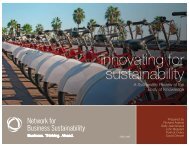embedding sustainability in organizational culture - Network for ...
embedding sustainability in organizational culture - Network for ...
embedding sustainability in organizational culture - Network for ...
Create successful ePaper yourself
Turn your PDF publications into a flip-book with our unique Google optimized e-Paper software.
Chapter 1: 6: Introduction Instill<strong>in</strong>g Capacity <strong>for</strong> Change<br />
49<br />
We were unable to locate studies that addressed the potential impact of<br />
benchmark<strong>in</strong>g on <strong>organizational</strong> <strong>culture</strong>. For <strong>in</strong>stance, would knowledge that the<br />
organization was either lagg<strong>in</strong>g or lead<strong>in</strong>g on a particular measure be motivat<strong>in</strong>g or<br />
demotivat<strong>in</strong>g, and under what circumstances?<br />
assessment: proposed but not tested<br />
pilot: Make a <strong>for</strong>mal decision to undertake new <strong>in</strong>itiatives or practices as a<br />
test or trial<br />
• Adopt <strong>in</strong>itiatives that orig<strong>in</strong>ated at the grassroots level as <strong>for</strong>mal<br />
pilot projects<br />
• Welcome proposals and suggestions, and follow through by<br />
allocat<strong>in</strong>g resources to pilot<strong>in</strong>g the best ideas<br />
• Set <strong>in</strong>ternal targets <strong>for</strong> f<strong>in</strong>d<strong>in</strong>g and execut<strong>in</strong>g pilot projects<br />
Ideas that develop at the grassroots level need to f<strong>in</strong>d their way <strong>in</strong>to the <strong>for</strong>mal<br />
structures of the organization if they are ever to become embedded as new practices.<br />
Pilot<strong>in</strong>g is one way of mak<strong>in</strong>g this transition.<br />
Organizations need to create a supportive environment that allows <strong>for</strong> new ideas<br />
to be given the chance to germ<strong>in</strong>ate, be prototyped and be implemented (Laszlo,<br />
2003). Willard (2009) po<strong>in</strong>ts to the importance of pilot programs <strong>in</strong> stimulat<strong>in</strong>g<br />
ideas and feedback. He suggests that organizations select areas where the conditions<br />
are favourable <strong>for</strong> successfully <strong>in</strong>cubat<strong>in</strong>g new <strong>susta<strong>in</strong>ability</strong> solutions. Hart (2005)<br />
advocates that organizations create structures and allocate separate funds to allow<br />
<strong>in</strong>ternal entrepreneurs to build and <strong>in</strong>cubate new ideas. He found that sett<strong>in</strong>g<br />
targets <strong>for</strong> pilot projects is a way to encourage new ideas with<strong>in</strong> the organization.<br />
In the safety literature, McCarthy and Blumenthal (2006) provide evidence that<br />
<strong>in</strong>itiat<strong>in</strong>g change <strong>in</strong> a s<strong>in</strong>gle department and then replicat<strong>in</strong>g successful processes<br />
and practices <strong>in</strong> other areas of the organization can be effective <strong>in</strong> build<strong>in</strong>g an<br />
<strong>organizational</strong> <strong>culture</strong> of safety.<br />
Formal research <strong>in</strong> the area of <strong>susta<strong>in</strong>ability</strong> has not explored the impact of pilot<br />
programs on <strong>embedd<strong>in</strong>g</strong> new ideas <strong>in</strong>to the organization. Given the <strong>in</strong>dications of<br />
the success of pilot<strong>in</strong>g <strong>in</strong> the safety literature, this may well be a practice worthy of<br />
more <strong>in</strong>vestigation.<br />
assessment: proposed but not tested<br />
lEaRn fRoM failuRE: Establish processes to gather new knowledge and<br />
skills from the analysis of past mistakes<br />
• Dedicate resources to <strong>in</strong>vestigat<strong>in</strong>g failures<br />
• Develop a process <strong>for</strong> mak<strong>in</strong>g recommendations <strong>for</strong> improvement<br />
• Take advantage of failures and see them as opportunities <strong>for</strong><br />
significant trans<strong>for</strong>mational and susta<strong>in</strong>able change<br />
Sometimes an organization will make mistakes. Whether it is a failure to execute<br />
a rout<strong>in</strong>e task or a miscalculation <strong>in</strong> the process of <strong>in</strong>novation, organizations need<br />
to view moments of failure as opportunities to improve and create momentum <strong>for</strong><br />
change.<br />
In Hagen’s (2008) study, acknowledg<strong>in</strong>g, deal<strong>in</strong>g with, and publicly communicat<strong>in</strong>g<br />
a <strong>susta<strong>in</strong>ability</strong> failure led to an upsurge <strong>in</strong> the focus on environmental issues. Once<br />
the crisis was over, the organization entered a phase of soul search<strong>in</strong>g and learn<strong>in</strong>g,<br />
try<strong>in</strong>g to figure out what went wrong and how they could improve.<br />
In the safety literature, learn<strong>in</strong>g from failures was approached by means of a nonpunitive<br />
process of report<strong>in</strong>g un<strong>in</strong>tentional and non-crim<strong>in</strong>al errors. This <strong>in</strong>volved<br />
clearly def<strong>in</strong><strong>in</strong>g crim<strong>in</strong>al errors (those <strong>in</strong>volv<strong>in</strong>g substance abuse or <strong>in</strong>tentional<br />
harm) and putt<strong>in</strong>g <strong>in</strong> place procedures <strong>for</strong> determ<strong>in</strong><strong>in</strong>g what happened; why it<br />
happened; and what could be done to prevent it from happen<strong>in</strong>g aga<strong>in</strong>. In this way,<br />
the organization discovered vulnerabilities <strong>in</strong> its systems and was able to develop<br />
and monitor system improvements (McCarthy & Blumenthal, 2006).<br />
More research is required to understand how organizations can ensure that they<br />
learn from their failures to implement or advance <strong>susta<strong>in</strong>ability</strong> and how they can<br />
best use failures as a catalyst <strong>for</strong> change.<br />
assessment: proposed but not tested<br />
REflEct: carefully consider what the organization is do<strong>in</strong>g; ask questions<br />
about what the organization is do<strong>in</strong>g and why<br />
• Set regularly opportunities to reflect on priorities<br />
• Stand back and assess the macro perspective<br />
• Observe <strong>organizational</strong> trends and ensure these are consistent with<br />
<strong>susta<strong>in</strong>ability</strong> values<br />
• Take a holistic view and be aware of the organization’s surround<strong>in</strong>gs
















